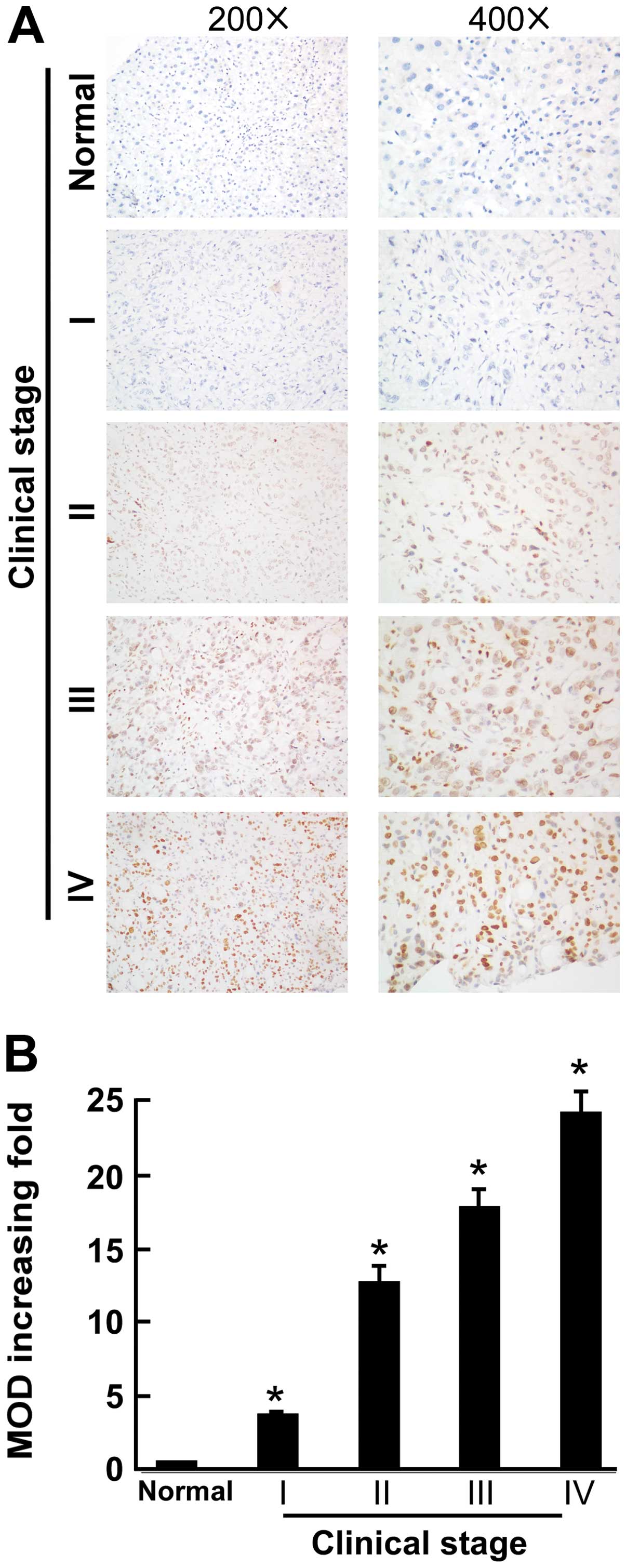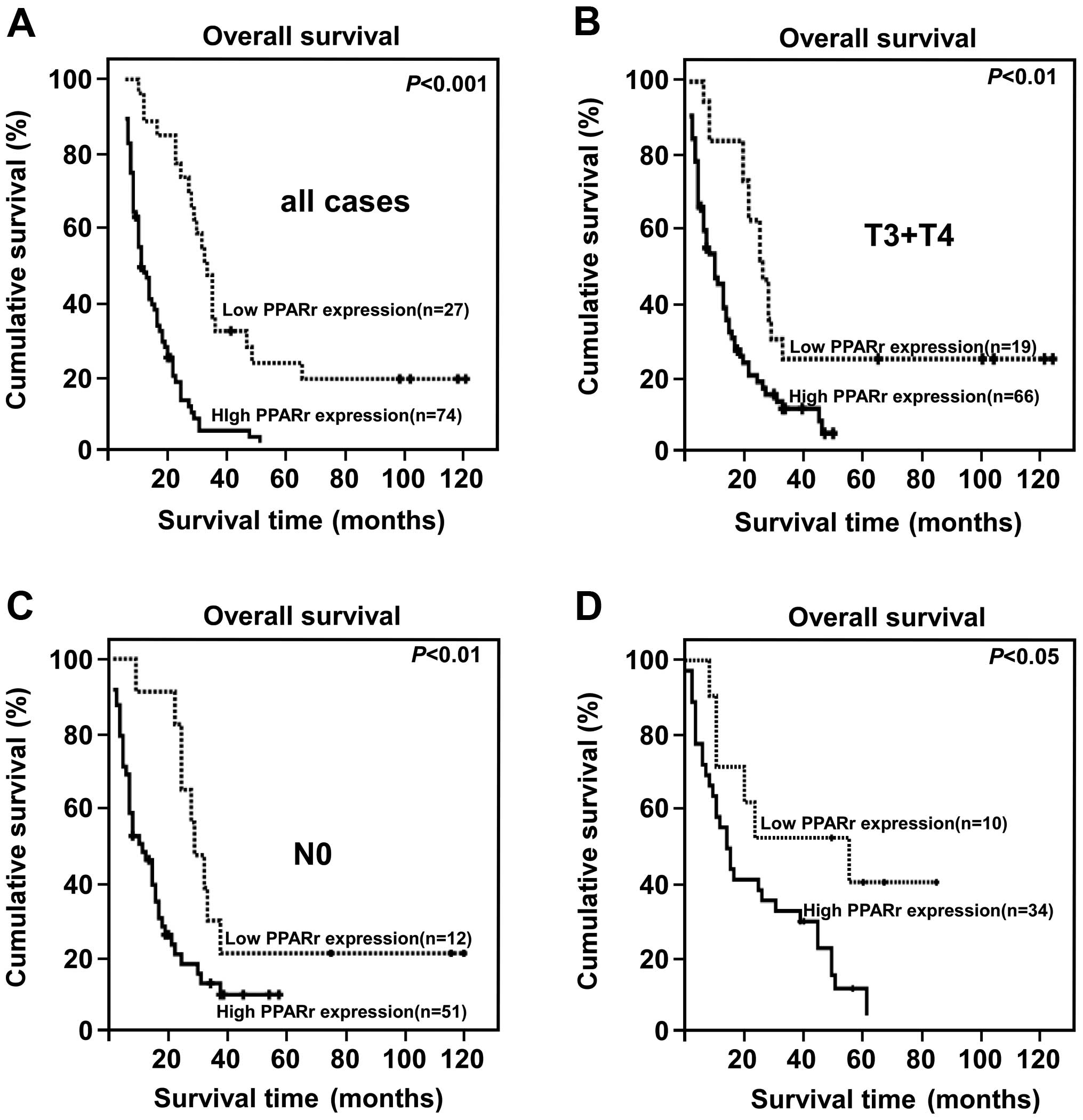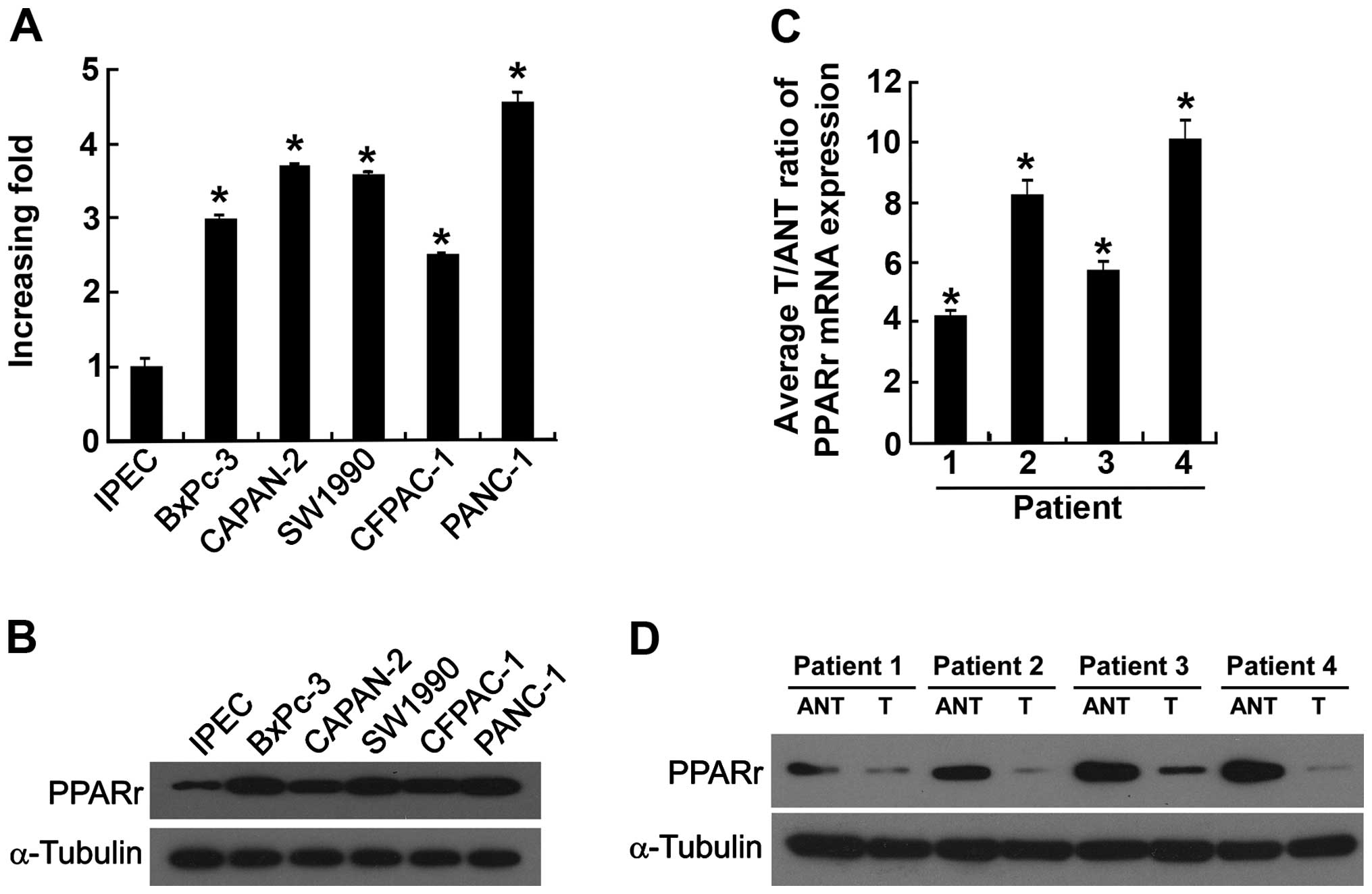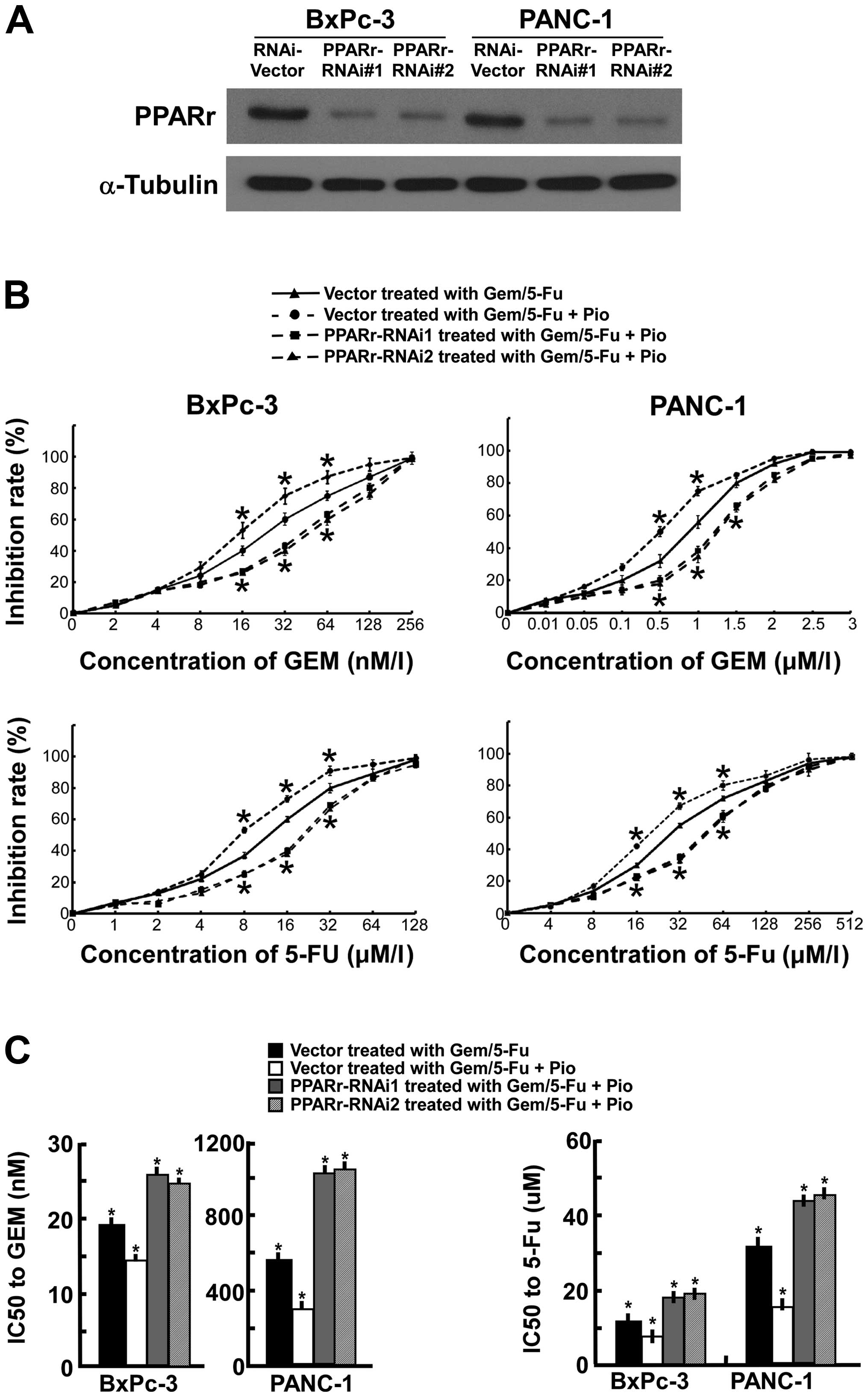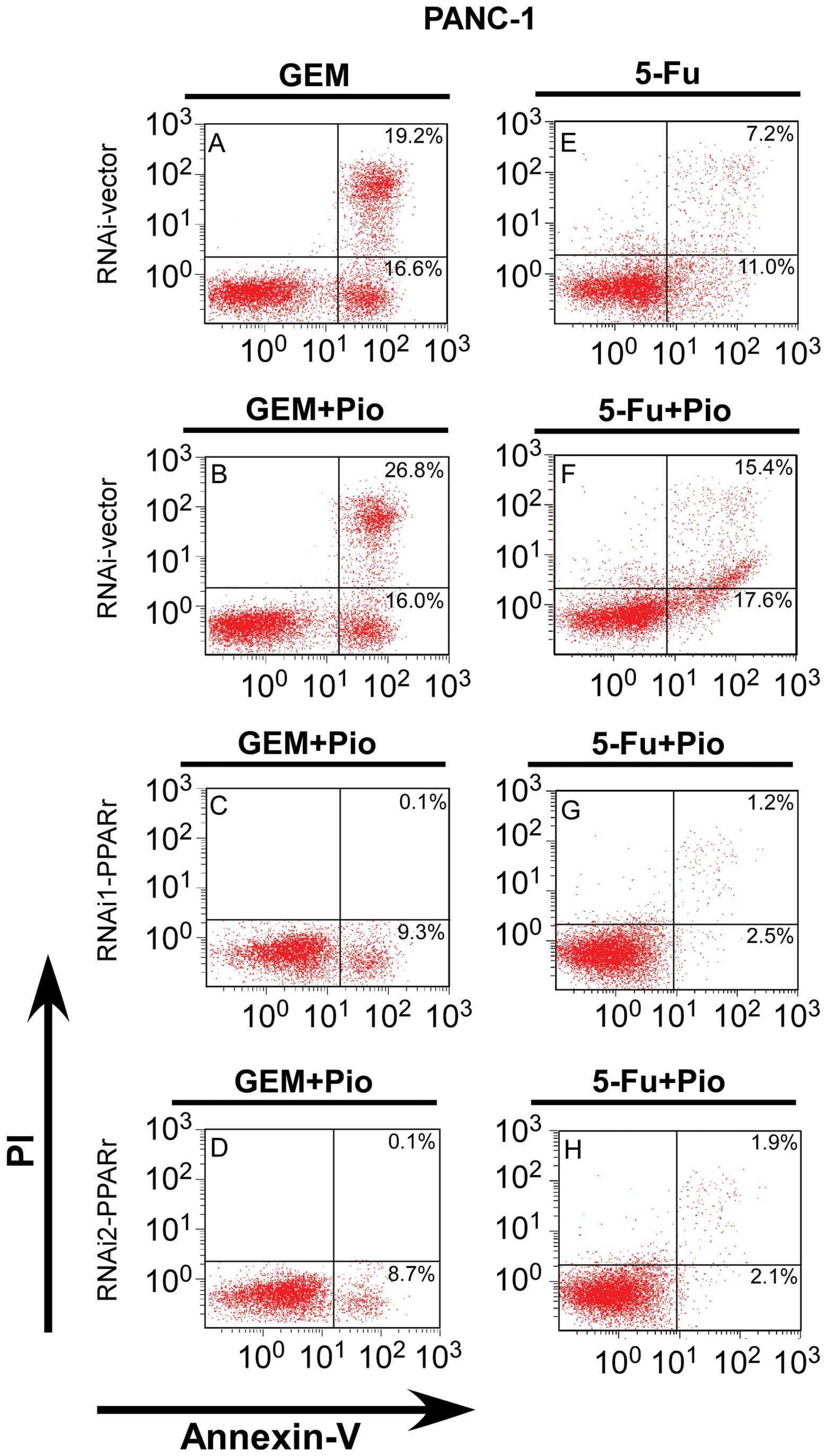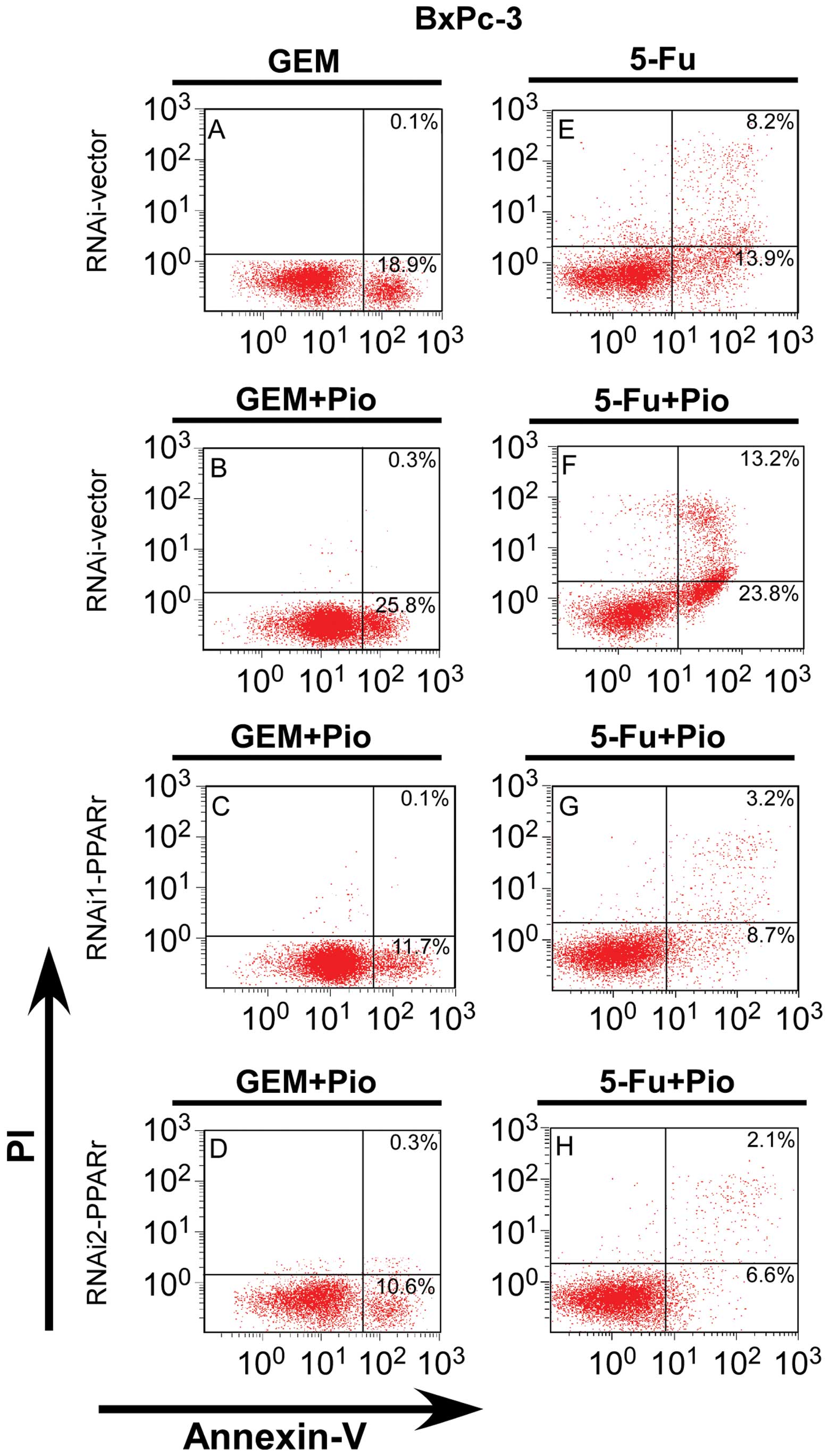Prognostic significance and therapeutic implications of peroxisome proliferator-activated receptor γ overexpression in human pancreatic carcinoma
- Authors:
- Published online on: October 17, 2014 https://doi.org/10.3892/ijo.2014.2709
- Pages: 175-184
Abstract
Introduction
Pancreatic cancer (PC) is the fourth-leading cause of cancer related mortality in the United States with a 5-year survival rate of <7% (1–3). In 2012, >43,920 new cases of PC were estimated to be diagnosed and 37,390 deaths due to PC were expected in the United States (3). Despite recent progress in diagnosis and treatment, the prognosis of patients with PC still remains unsatisfactory and unpredictable, due to the invasive phenotype, early metastasis and high rate of resistance to existing chemo-radiotherapeutic strategies (4). Thus, identification of the biological changes that occur during the progression of PC, and the identification of novel markers of treatment sensitivity to more accurately predict clinical outcome will help to provide effective, individual treatment strategies for PC patients.
Numerous candidate genes have been screened in an attempt to specifically target pancreatic cancer cells and as therapeutic target genes, peroxisome-proliferator-activated receptor-gamma (PPARγ) is one of them. PPARγ is a member of the PPAR nuclear receptor superfamily of ligand-activated transcription factors. Three subtypes of PPARs with different tissue distributions and ligand specificities have been identified: PPARα, PPARβ/δ and PPARγ (5,6). PPARγ is expressed at high levels in fat tissue and a number of other tissues, such as muscle, adrenal gland and liver (7–10), as well as endothelial cells (11,12).
PPARγ is activated by the binding of specific ligands, and forms a complex with retinoid X receptors (13). The PPAR/ retinoid X receptor complex binds to specific peroxisome proliferator response elements (PPRE) which control the expression of a variety of target genes (14), to regulate cell proliferation, angiogenesis and inflammation (15–17). PPARγ is also required for adipogenesis, as it plays a key regulatory role in adipose cell differentiation and glucose homeostasis (18). Recent research revealed that PPARγ also participates in the biological mechanisms underlying carcinogenesis, including cancer cell proliferation and differentiation in vitro and in vivo (19,20). PPARγ is overexpressed in a variety of human cancers, including PC, breast cancer, prostate cancer, non-small cell lung carcinoma and ovarian cancer (21–27).
In this study, we investigated the relationship between PPARγ expression and the clinicopathological features of PC, overall survival (OS) in PC, and chemoresistance in PC cells. Our results strongly suggest that PPARγ might be a potential therapeutic target for PC.
Materials and methods
Patients
In the present study, 101 PC patients who were histopathologically diagnosed after surgical resection at the Department of Gastrointestinal Surgery and Pathology (Sun Yat-sen University Cancer Center) from January 1999 to December 2010 were retrospectively enrolled. Gemcitabine-based chemotherapy was administered to the 44 patients with advanced-stage disease after surgery; none of the patients received radiotherapy. The clinicopathological features of the patient cohort are listed in Table I. All patients were followed-up on regular basis; last follow-up was May 2011 with a mean follow-up time of 19 months (range, 1–122 months), during which time 84 cancer-related deaths occurred. Four fresh PC and paired adjacent non-cancerous pancreatic tissues were collected for real-time quantitative polymerase chain reaction (qRT-PCR) and western blot analysis. All of the patients provided consent for the use of their paraffin embedded tissues for research purposes.
In order to use these clinical materials for research-purposes, the patient’s prior consent and approval from the Institutional Research Ethics Committee of the Sun Yat-sen University Cancer Center were obtained. Clinicopathological classification and staging were determined according to the criteria proposed by the American Joint Committee on Cancer and International Union Against Cancer criteria.
Cell lines and plasmids
The human immortalized pancreatic ductal epithelial cell line (IPEC) hTERT-HPNE E6/E7 and PC cell lines, including BxPc-3, Capan-2, SW1990, CFPAC-1 and PANC-1 were obtained from the American Type Culture Collection (Manassas, VA, USA). All cell lines were maintained in DMEM medium (Invitrogen, Carlsbad, CA, USA) supplemented with 10% fetal bovine serum (Hyclone, Logan, UT, USA).
For depletion of PPARγ, two human short hairpin RNA (shRNA) sequences were individually cloned into the pSuper- retro-neo plasmid to generate pSuper-retro-PPARγ-RNAi(s), respectively; the sequences were RNAi#1: GCGGAGATCTCC AGTGATATC and RNAi#2: GCTGAATGTGAAGCCCAT TGA (synthesized by Invitrogen). Retroviral production and infection were performed as previously described (28). Stable cell lines expression PPARγ or PPARγ short hairpin RNAs (shRNA) were selected for 10 days with 0.5 μg/ml puromycin.
RNA extraction, reverse transcription and real-time PCR
Total RNA was extracted from cultured cells using TRIzol reagent (Invitrogen) following the manufacturer’s instructions, and cDNA was amplified and quantified by quantitative real-time PCR (qRT-PCR) using the ABI PRISM 7500 Sequence Detection System (Applied Biosystems, Grand Island, NY, USA) with SYBR Green I (Molecular Probes, Grand Island, NY, USA). The qRT-PCR primers were selected as follows: PPARγ, forward 5′-GAGTACCAAAGTGC AATCAAAGTG-3′ and reverse 5′-TCTCCACAGACACGAC ATTC-3′. Expression data were normalized to the geometric mean of house-keeping gene GAPDH (forward: 5′-ACCACA GTCCATGCCATCAC-3′ and reverse: 5′-TCCACCACCCTGT TGCTGTA-3′) to control the variability in expression levels and calculated as, where Ct represents the threshold cycle for each transcript.
Immunohistochemistry
Immunohistochemical analysis was performed to evaluate PPARγ protein expression in the 101 human fine-needle aspirations of PC tissues and 4 fresh pancreatic tissues. In brief, paraffin-embedded specimens were cut into 4-μm sections, baked at 60°C for 2 h, deparaffinized with xylene, rehydrated, subjected to antigen retrieval by microwaving in EDTA antigen retrieval buffer, and treated with 3% hydrogen peroxide in methanol to quench endogenous peroxidase activity, followed by 1% bovine serum albumin to block non-specific binding. The sections were incubated with rabbit anti-PPARγ (1:100; Santa Cruz Biotechnology, Santa Cruz, CA, USA) overnight at 4°C. Normal goat serum was used as a negative control. After washing, the tissue sections were incubated with biotinylated anti-rabbit secondary antibody (Zymed, San Francisco, CA, USA) followed by strep-tavidin-horseradish peroxidase complex (Zymed). The sites of immunoreactivity were visualized using the 3.3′-diami-nobenzidine (ZSGB-Bio, Beijing, China) and the sections were counterstained with 10% Mayer’s hematoxylin (Sigma-Aldrich, St. Louis, MO, USA), dehydrated and mounted.
PPARγ staining was scored as: i) the percentage of positive tumor cells in the tumor tissue (0, 1–5%; 1, 6–25%; 2, 26–50%; 3, 51–75%; 4, 76–100%) and ii) the staining intensity: (0, no signal; 1, weak; 2, moderate; 3, strong). The immunoreactivity score (IRS) was calculated by multiplying the score for the percentage of positive cells and the intensity score (possible range, 0–7) (29). IRS scores ≥3 were considered high expression. IHC staining was quantitatively analyzed using the Axio Vision Rel.4.6 computerized image analysis system assisted with an automatic measurement program (Carl Zeiss, Oberkochen, Baden-Württemberg, Germany). Briefly, the stained sections were evaluated at ×200 magnification, and 10 representative stained fields in each section were analyzed to determine the mean optical density (MOD), which represents the strength of the staining signal as the percentage of positive pixels. The MOD data were analyzed using the t-test to compare the average MOD difference between different groups of tissues; P<0.05 was considered statistically significant.
MTT assay
Cells were incubated at 37°C in an incubator with 5% CO2. Cells at 0.2×104 of each line were seeded in a 96-well microtiter plate and allowed to adhere to the plate for 24 h at 37°C. Cells were then treated for 72 h at 37°C with either gemcitabine (Eli Lilly and Co., Indianapolis, IN, USA) or 5-fluorouracil (5-FU) (Sigma-Aldrich) with or without Pioglitazone (Pio, Takeda Pharmaceutical Co. Ltd., Osaka, Japan) at various concentrations, as indicated in the figure legends. At the appropriate time-points, the cells were incubated with 100 μl 3-(4,5-dimethylthiazol-2-yl)-2,5-diphenyltetrazolium bromide (MTT) dye (0.5 mg/ml; Sigma-Aldrich) for 4 h, the culture medium was removed and 150 μl of dimethyl sulfoxide (DMSO) (Sigma-Aldrich) was added to dissolve the formazan crystals. The absorbance values were measured by Spectra Max M5 spectrometer (Molecular Devices, Sunnyvale, CA, USA) at 570 nm, with 630 nm as the reference wavelength. All experiments were carried out in triplicate. In MTT assay, there is a linear relationship between the OD reading and the number of viable cells. Percent drug killing of cancer cells = (ODcontrol well - ODdrug-exposed well) / (ODcontrol well - ODblank well) × 100%. The average OD readings were obtained from 3 duplicate wells in any one MTT assay, all experiments were carried out in triplicate.
Flow cytometry analysis
Early and late cell apoptosis was measured by flow cytometry using Annexin V and PI provided in a commercial kit (Biovision, Zurich, Switzerland) according to the manufacturer’s protocol. Briefly, the cells were seeded in a 6-well plate at a density of 1×106 cells/well and remained in spontaneous culture media at 37°C with 5% CO2 for 24 h at 37°C. Then the cells were treated for 48 h at 37°C with either gemcitabine or 5-fluorouracil with or without Pio at various concentrations as indicated in the figure legends. On the test day, 1×105 trypsinized cells were washed twice in PBS and resuspended in 100 μl of binding buffer, then suspended in Annexin V-binding buffer, stained with Annexin V-FITC for 15 min at room temperature, washed and stained with PI. The samples were analyzed using a FACSCalibur flow cytometer equipped with CellQuest-Pro software (Becton-Dickinson, San Jose, CA, USA).
Western blotting
The fresh tissues were ground to a powder in liquid nitrogen, lysed with sampling buffer [62.5 mmol/l Tris-HCl (pH 6.8), 2% SDS, 10% glycerol and 5% 2-β-mercaptoethanol], and the protein concentrations were determined using the Bradford assay (Bio-Rad Laboratories, Berkeley, CA, USA). Equal amounts of protein were electrophoretically separated on 9% polyacrylamide SDS gels (SDS-PAGE) and transferred to polyvinylidene fluoride membranes (Amersham Pharmacia Biotech, QC, Canada). The membranes were incubated with an anti-PPARγ mouse antibody (1:100; Santa Cruz Biotechnology), followed by a horseradish peroxidase-conjugated anti-mouse IgG antibody (1:2,000; Amersham Pharmacia Biotech) and the bands were detected using an enhanced chemiluminescence kit (Amersham Pharmacia Biotech) according to the manufacturer’s instructions. The membranes were subsequently stripped and re-probed with an anti-tubulin mouse monoclonal antibody (1:2,000; Sigma-Aldrich) as a loading control.
Statistical analysis
All statistical analyses were carried out using SPSS version 13.0 (SPSS, Chicago, IL, USA). Comparisons between groups were performed using two-tailed paired Student’s t-tests. The relationships between PPARγ expression and the patient clinicopathological features were analyzed using the χ2 test. Survival curves were plotted by the Kaplan-Meier method and compared using the log-rank test. Survival data were evaluated using univariate and multivariate Cox regression analyses. P-values <0.05 were considered statistically significant for all analyses.
Results
Association between PPARγ and clinical stage in PC
The association between PPARγ expression level and clinicopatholigical characteristics in PC patients was studied. PPARγ expression was examined in 101 fine-needle aspirations of PC tissues, including 21 cases of clinical stage I (20.8%), 53 cases of stage II (52.5%), 15 cases of stage III (14.9%) and 12 cases of stage IV (11.9%) PC. Significant correlation was observed between PPARγ expression level and several prognostic risk factors such as clinical stage, T classification and N classification (Table I). PPARγ immunostaining was localized in the nucleus. The IHC analysis demonstrated that PPARγ was markedly upregulated in PC tissues, but it was only marginally detectable or not at all in normal pancreatic tissues (P<0.05, Fig. 1A). Quantitative analysis of the IHC staining using the MOD scores indicated that PPARγ expression in clinical stage I to stage IV primary PC was significantly higher than normal pancreatic tissues (P<0.05, Fig. 1B).
High PPARγ expression is associated with poor prognosis in PC, especially in patients with advanced disease who received postoperative chemotherapy
The PC patients were divided into two groups: high and low PPARγ expression based on the IRS score determined during IHC analysis (high = IRS score ≥4). Kaplan-Meier and log-rank analysis demonstrated a significant difference in the overall survival time of patients with low and high PPARγ expression. High PPARγ expression was closely associated with poor overall survival (P<0.001, Fig. 2A). Furthermore, high PPARγ expression correlated strongly with poor overall survival in the subsets of patients with T3+T4 disease or N0 disease (both P<0.001; Fig. 2B and C). Interestingly, high PPARγ protein expression also correlated significantly with poorer overall survival in patients who received postoperative treatment for advanced disease (P<0.001, Fig. 2D). PPARγ protein expression correlated significantly with the clinical stage, T classification, N classification, overall survival and survival of patients with chemotherapy regimen after surgery (Table II). Moreover, univariate and multivariate analyses revealed that clinical stage, the T classifications and PPARγ expression were each recognized as independent prognostic factors (Table III), suggesting that PPARγ expression can be utilized as a predictor of survival in PC patients, and also that patients with low levels of PPARγ expression might experience greater benefit from adjuvant therapy.
Table IIIUnivariate and multivariate analyses of various prognostic parameters in patients with PC Cox-regression analysis. |
PPARγ is upregulated in human pancreatic cancer
To investigate the potential role of PPARγ in the progression of PC, Western blotting, qRT-PCR and IHC analyses were performed on PC cell lines (BxPc-3, Capan-2, SW 1990, CFPAC-1, PANC-1), immortalized pancreatic epithelial cells (IPECs) and four freshly isolated PC tissues and the paired adjacent non-cancerous tissues. As shown in Fig. 3A and B both PPARγ mRNA and protein were markedly upregulated in all of the PC cell lines tested, compared with IPECs. The expression of PPARγ mRNA was 4- to 10-fold higher in PC tissues than the adjacent non-tumor tissues (Fig. 3C). Furthermore, comparative analysis revealed that PPARγ protein expression was upregulated in all four of the freshly isolated PC tissues, compared with the matched adjacent non-tumor tissues (Fig. 3D) suggesting that PPARγ is overexpressed in PC.
Silencing of PPARγ decreases the chemosensitivity of PC cells in vitro
To investigate the impact of PPARγ on the efficacy of chemotherapy in PC, we used PPARγ ligand pioglitazone and two short hairpin RNAs for PPARγ was employed to suppress endogenous PPARγ expression stably in BxPc-3 and PANC-1 cell lines. Western blot analysis revealed that the amount of PPARγ protein in PPARγ RNAi(s) cells, normalized by α-tubulin, was reduced up to 80% compared with PPARγ RNAi-vector cells (Fig. 4A). The PANC-1 and BxPc-3 cells were exposed to Gem alone or Gem plus PPARγ ligand (10 μM Pio) with or without PPARγ knockdown. After 72-h treatment, greater apoptosis was observed in the cells treated with Gem plus PPARγ ligand, compared with the cells treated with Gem alone. The PPARγ-RNAi(s) cells treated with Gem plus PPARγ ligand showed minimal apoptosis, compared with the vehicle treated with Gem alone or Gem plus PPARγ ligand. Similar results were observed in the cells exposed to 5-FU alone or 5-FU plus PPARγ ligand (10 μM Pio) with or without PPARγ knockdown (Fig. 4B). As shown in Fig. 4C, silencing of endogenous PPARγ increased Gem plus Pio IC50 values 3.5- and 1.7-fold for Panc-1 and BxPc-3 cells, increased 5-FU plus Pio IC50 values 2.6- and 2.4-fold, respectively. Futhermore, the PPARγ-RNAi(s) cells Gem or 5-FU plus Pio IC50 values significantly lower than the vector cells incubated with Gem or 5-FU alone (P<0.01). These results indicate that downregulation of PPARγ decreased the cytotoxic effects of Gem and 5-FU in pancreatic cancer cells.
Silencing of PPARγ inhibited apoptosis of PC cells in vitro
As shown in Fig. 5A–D, downregulated of PPARγ inhibited the percentage of apoptotic PANC-1 cells after the cells were treated in 500 nm Gem plus 10 μM Pio for 48 h, compared with the PPARγ-RNAi vector cells treated with Gem alone or Gem plus Pio, respective (P<0.01). Similarly, the apoptosis rate of the PANC-1 PPARγ-RNAi(s) cells treated with 5-FU (40 μM) plus Pio (10 μM) clearly lower than the PPARγ-vector cells treated with 5-FU plus Pio or with 5-FU alone, which were (3.7±0.3, 4.0±0.5), (33.0±1.8) and (18.2±2.2)%, respectively (P<0.01, Fig. 5E–H). Similar situation appeared when BxPc-3 PPARγ-RNAi(s) cells and PPARγ-RNAi vector cells were treatment with drugs: the precentage of early and late apoptotic BxPc-3 PPARγ-RNAi(s) cells treated with Gem/5-FU plus Pio were clearly lower than the PPARγ-vector cells, also lower than the PPARγ-vector cells treated with Gem/5-FU alone (P<0.01, Fig. 6). These results indicate that downregulation of PPARγ decreased the antitumor effects on pancreatic cancer cells and is a potent apoptosis inhibitor.
Discussion
PPARγ is known to be overexpressed in various tumors, including hematologic malignancies (30,31) and solid tumors (32–36). The expression of PPARγ has previously been reported in PC cell lines and tissues, including SUIT-2, AsPC-1, BxPC-3, Capan-2, HPAF-II, MIA Paca-2 and PANC-1 cells (27,37–39). Sasaki et al found that PPARγ mRNA was expressed in five of seven human PC samples, whereas PPARγ expression was not detected in the adjacent normal tissues (27). Itami et al conducted immunohistochemistry and demonstrated that 75% of 47 primary PC tissues and 80% of 15 liver PC metastases expressed high levels of PPARγ (39). The findings of our study are in agreement with these results, as we observed that PPARγ mRNA and protein were overexpressed in PC cell lines and primary PC tissues, compared to IPECs and the paired adjacent non-cancerous tissues. PPARγ has previously been associated with shorter overall survival in PC (22). Our study confirms this result, especially in patients with advanced disease who received postoperative chemotherapy.
PPARγ can regulate cell proliferation, angiogenesis and inflammation (15–17). Previous in vitro studies have suggested that PPARγ plays an important role in PC. Eibl et al reported that PPARγ agonists time- and dose-dependently decreased the viability of PC cell lines (37). Kristiansen et al found that PPARγ is highly expressed in PC and is associated with shorter overall survival times (22). Our conclutions are consistent with this. More importantly, we demonstrated that PPARγ may play an important role in gemcitabine and 5-FU effect of PC patients, because for the patients with advanced PC who received postoperative chemotherapy, increased expression of PPARγ associated with poor prognosis.
Gemcitabine and 5-FU are the most commonly used chemotherapeutic agent for PC; however, the clinical benefits of these drugs are not obvious (40,41). The poor response to chemotherapy in PC patients may due to inherent chemoresistance of PC cells and impaired drug delivery pathways (42). There has been some research on the resistance aspects of gemcitabine and 5-FU. Leung et al found that suppression of Lipocalin2 (LCN2) in PC cells increased their sensitivity to gemcitabine in vitro, and in vivo (43). Awasthi et al reported that insulin-like growth factor (IGF) signaling proteins are frequently overexpressed in pancreatic duct adenocarcinoma (PDAC), and using a small molecular inhibitor of IGF receptor (BMS-754807) was able to enhance gemcitabine response in PC (44). Wang et al reported that the proliferation was inhibited more significantly in MIA Paca-2 and PANC-1 cells when treated with Ad-PUMA combined with anticancer drugs (cDDP, 5-FU, Gem) than when treated with anticancer drugs alone (45).
Our data demonstrated that for the patients with advanced PC who received postoperative chemotherapy including gemcitabine and 5-FU, increased expression of PPARγ associated with poor prognosis. Next, we examined the functional involvement of the PPARγ in Gem or 5-FU induced apoptosis using PPARγ ligand pioglitazone and PPARγ-RNAi(s) cells. The cell function results and the clinical data appears to be inconsistent, because our in vitro results suggest that PPARγ increased sensitivity of chemotherapy in PC cells. Silencing of PPARγ significantly declined the chemosensitivity of PANC-1 and BxPc-3 cells to gemcitabine/5-FU plus PPARγ ligand, compared with the vector cells treated with gemcitabine/5-FU alone or gemcitabine/5-FU plus PPARγ ligand. We thought that the higher levels of PPARγ in chemoresistant cells, potentially make the cells more susceptible to the ligand therapy. This suggests that the high levels of PPARγ expressed in PC are involved in gemcitabine and 5-FU sensitivity, and also indicates that overexpression of PPARγ may be an adaptive response which mediates chemosensitivity in PC cells. Further characterization of the mechanisms by how PPARγ enables chemosensitivity in PC is still unclear, and further studies are needed to clarify the therapeutic potential of PPARγ for this deadly disease.
Acknowledgements
This study was supported by the National High-tech R&D Program (863 Program), China (no. 2012AA02A506); and the Science and Technology Department of Guangdong Province, China (no. 2012B031800088).
References
|
Pliarchopoulou K and Pectasides D: Pancreatic cancer: current and future treatment strategies. Cancer Treat Rev. 35:431–436. 2009. View Article : Google Scholar : PubMed/NCBI | |
|
Ramon Torrell JM and Serra Majem L: Descriptive epidemiology of cancer of the stomach in Catalonia 1983–1986. Gac Sanit. 4:76–77. 1990.(In Spanish). | |
|
Siegel R, Naishadham D and Jemal A: Cancer statistics, 2012. CA Cancer J Clin. 62:10–29. 2012. View Article : Google Scholar | |
|
Bardeesy N and DePinho RA: Pancreatic cancer biology and genetics. Nat Rev Cancer. 2:897–909. 2002. View Article : Google Scholar | |
|
Michalik L, Auwerx J, Berger JP, et al; International Union of Pharmacology. LXI Peroxisome proliferator-activated receptors. Pharmacol Rev. 58:726–741. 2006. View Article : Google Scholar : PubMed/NCBI | |
|
Kersten S, Desvergne B and Wahli W: Roles of PPARs in health and disease. Nature. 405:421–424. 2000. View Article : Google Scholar : PubMed/NCBI | |
|
Zhu YJ, Crawford SE, Stellmach V, et al: Coactivator PRIP, the peroxisome proliferator-activated receptor-interacting protein, is a modulator of placental, cardiac, hepatic, and embryonic development. J Biol Chem. 278:1986–1990. 2003. View Article : Google Scholar | |
|
Lemberger T, Desvergne B and Wahli W: Peroxisome proliferator-activated receptors: a nuclear receptor signaling pathway in lipid physiology. Annu Rev Cell Dev Biol. 12:335–363. 1996. View Article : Google Scholar : PubMed/NCBI | |
|
Auboeuf D, Rieusset J, Fajas L, et al: Tissue distribution and quantification of the expression of mRNAs of peroxisome proliferator-activated receptors and liver X receptor-alpha in humans: no alteration in adipose tissue of obese and NIDDM patients. Diabetes. 46:1319–1327. 1997. View Article : Google Scholar | |
|
Kliewer SA, Forman BM, Blumberg B, et al: Differential expression and activation of a family of murine peroxisome proliferator-activated receptors. Proc Natl Acad Sci USA. 91:7355–7359. 1994. View Article : Google Scholar : PubMed/NCBI | |
|
Bishop-Bailey D and Hla T: Endothelial cell apoptosis induced by the peroxisome proliferator-activated receptor (PPAR) ligand 15-deoxy-Delta12, 14-prostaglandin J2. J Biol Chem. 274:17042–17048. 1999. View Article : Google Scholar : PubMed/NCBI | |
|
Xin X, Yang S, Kowalski J and Gerritsen ME: Peroxisome proliferator-activated receptor gamma ligands are potent inhibitors of angiogenesis in vitro and in vivo. J Biol Chem. 274:9116–9121. 1999. View Article : Google Scholar : PubMed/NCBI | |
|
Marcus SL, Miyata KS, Zhang B, Subramani S, Rachubinski RA and Capone JP: Diverse peroxisome proliferator-activated receptors bind to the peroxisome proliferator-responsive elements of the rat hydratase/dehydrogenase and fatty acyl-CoA oxidase genes but differentially induce expression. Proc Natl Acad Sci USA. 90:5723–5727. 1993. View Article : Google Scholar | |
|
Kliewer SA, Umesono K, Mangelsdorf DJ and Evans RM: Retinoid X receptor interacts with nuclear receptors in retinoic acid, thyroid hormone and vitamin D3 signalling. Nature. 355:446–449. 1992. View Article : Google Scholar : PubMed/NCBI | |
|
Ramachandran L, Manu KA, Shanmugam MK, et al: Isorhamnetin inhibits proliferation and invasion and induces apoptosis through the modulation of peroxisome proliferator-activated receptor gamma activation pathway in gastric cancer. J Biol Chem. 287:38028–38040. 2012. View Article : Google Scholar | |
|
Bishop-Bailey D: PPARs and angiogenesis. Biochem Soc Trans. 39:1601–1605. 2011. View Article : Google Scholar | |
|
Jung UJ, Torrejon C, Chang CL, Hamai H, Worgall TS and Deckelbaum RJ: Fatty acids regulate endothelial lipase and inflammatory markers in macrophages and in mouse aorta: a role for PPARgamma. Arterioscler Thromb Vasc Biol. 32:2929–2937. 2012. View Article : Google Scholar : PubMed/NCBI | |
|
Tontonoz P, Hu E and Spiegelman BM: Stimulation of adipogenesis in fibroblasts by PPAR gamma 2, a lipid-activated transcription factor. Cell. 79:1147–1156. 1994. View Article : Google Scholar : PubMed/NCBI | |
|
Gelman L, Fruchart JC and Auwerx J: An update on the mechanisms of action of the peroxisome proliferator-activated receptors (PPARs) and their roles in inflammation and cancer. Cell Mol Life Sci. 55:932–943. 1999. View Article : Google Scholar : PubMed/NCBI | |
|
Fajas L, Debril MB and Auwerx J: Peroxisome proliferator-activated receptor-gamma: from adipogenesis to carcinogenesis. J Mol Endocrinol. 27:1–9. 2001. View Article : Google Scholar : PubMed/NCBI | |
|
Wang T, Xu J, Yu X, Yang R and Han ZC: Peroxisome proliferator-activated receptor gamma in malignant diseases. Crit Rev Oncol Hematol. 58:1–14. 2006. View Article : Google Scholar : PubMed/NCBI | |
|
Kristiansen G, Jacob J, Buckendahl AC, et al: Peroxisome proliferator-activated receptor gamma is highly expressed in pancreatic cancer and is associated with shorter overall survival times. Clin Cancer Res. 12:6444–6451. 2006. View Article : Google Scholar | |
|
Watkins G, Douglas-Jones A, Mansel RE and Jiang WG: The localisation and reduction of nuclear staining of PPARgamma and PGC-1 in human breast cancer. Oncol Rep. 12:483–488. 2004.PubMed/NCBI | |
|
Segawa Y, Yoshimura R, Hase T, et al: Expression of peroxisome proliferator-activated receptor (PPAR) in human prostate cancer. Prostate. 51:108–116. 2002. View Article : Google Scholar : PubMed/NCBI | |
|
Theocharis S, Kanelli H, Politi E, et al: Expression of peroxisome proliferator activated receptor-gamma in non-small cell lung carcinoma: correlation with histological type and grade. Lung Cancer. 36:249–255. 2002. View Article : Google Scholar : PubMed/NCBI | |
|
Zhang GY, Ahmed N, Riley C, et al: Enhanced expression of peroxisome proliferator-activated receptor gamma in epithelial ovarian carcinoma. Br J Cancer. 92:113–119. 2005. View Article : Google Scholar : PubMed/NCBI | |
|
Sasaki T, Fujimoto Y, Tsuchida A, Kawasaki Y, Kuwada Y and Chayama K: Activation of peroxisome proliferator-activated receptor gamma inhibits the growth of human pancreatic cancer. Pathobiology. 69:258–265. 2001. View Article : Google Scholar : PubMed/NCBI | |
|
Hahn WC, Dessain SK, Brooks MW, et al: Enumeration of the simian virus 40 early region elements necessary for human cell transformation. Mol Cell Biol. 22:2111–2123. 2002. View Article : Google Scholar : PubMed/NCBI | |
|
Soumaoro LT, Uetake H, Higuchi T, Takagi Y, Enomoto M and Sugihara K: Cyclooxygenase-2 expression: a significant prognostic indicator for patients with colorectal cancer. Clin Cancer Res. 10:8465–8471. 2004. View Article : Google Scholar : PubMed/NCBI | |
|
Asou H, Verbeek W, Williamson E, et al: Growth inhibition of myeloid leukemia cells by troglitazone, a ligand for peroxisome proliferator activated receptor gamma, and retinoids. Int J Oncol. 15:1027–1031. 1999.PubMed/NCBI | |
|
Zang C, Liu H, Posch MG, et al: Peroxisome proliferator-activated receptor gamma ligands induce growth inhibition and apoptosis of human B lymphocytic leukemia. Leuk Res. 28:387–397. 2004. View Article : Google Scholar : PubMed/NCBI | |
|
Sato H, Ishihara S, Kawashima K, et al: Expression of peroxisome proliferator-activated receptor (PPAR)gamma in gastric cancer and inhibitory effects of PPARgamma agonists. Br J Cancer. 83:1394–1400. 2000. View Article : Google Scholar : PubMed/NCBI | |
|
Sarraf P, Mueller E, Smith WM, et al: Loss-of-function mutations in PPAR gamma associated with human colon cancer. Mol Cell. 3:799–804. 1999. View Article : Google Scholar : PubMed/NCBI | |
|
Mueller E, Sarraf P, Tontonoz P, et al: Terminal differentiation of human breast cancer through PPAR gamma. Mol Cell. 1:465–470. 1998. View Article : Google Scholar : PubMed/NCBI | |
|
Ogino S, Shima K, Baba Y, et al: Colorectal cancer expression of peroxisome proliferator-activated receptor gamma (PPARG, PPARgamma) is associated with good prognosis. Gastroenterology. 136:1242–1250. 2009. View Article : Google Scholar | |
|
Inoue K, Kawahito Y, Tsubouchi Y, et al: Expression of peroxisome proliferator-activated receptor gamma in renal cell carcinoma and growth inhibition by its agonists. Biochem Biophys Res Commun. 287:727–732. 2001. View Article : Google Scholar : PubMed/NCBI | |
|
Eibl G, Wente MN, Reber HA and Hines OJ: Peroxisome proliferator-activated receptor gamma induces pancreatic cancer cell apoptosis. Biochem Biophys Res Commun. 287:522–529. 2001. View Article : Google Scholar : PubMed/NCBI | |
|
Farrow B and Evers BM: Activation of PPARgamma increases PTEN expression in pancreatic cancer cells. Biochem Biophys Res Commun. 301:50–53. 2003. View Article : Google Scholar : PubMed/NCBI | |
|
Itami A, Watanabe G, Shimada Y, et al: Ligands for peroxisome proliferator-activated receptor gamma inhibit growth of pancreatic cancers both in vitro and in vivo. Int J Cancer. 94:370–376. 2001. View Article : Google Scholar : PubMed/NCBI | |
|
Katz MH, Fleming JB, Lee JE and Pisters PW: Current status of adjuvant therapy for pancreatic cancer. Oncologist. 15:1205–1213. 2010. View Article : Google Scholar : PubMed/NCBI | |
|
Squadroni M and Fazio N: Chemotherapy in pancreatic adenocarcinoma. Eur Rev Med Pharmacol Sci. 14:386–394. 2010.PubMed/NCBI | |
|
Duxbury MS, Ito H, Zinner MJ, Ashley SW and Whang EE: Inhibition of SRC tyrosine kinase impairs inherent and acquired gemcitabine resistance in human pancreatic adenocarcinoma cells. Clin Cancer Res. 10:2307–2318. 2004. View Article : Google Scholar : PubMed/NCBI | |
|
Leung L, Radulovich N, Zhu CQ, et al: Lipocalin2 promotes invasion, tumorigenicity and gemcitabine resistance in pancreatic ductal adenocarcinoma. PLoS One. 7:e466772012. View Article : Google Scholar : PubMed/NCBI | |
|
Awasthi N, Zhang C, Ruan W, Schwarz MA and Schwarz RE: BMS-754807, a small-molecule inhibitor of insulin-like growth factor-1 receptor/insulin receptor, enhances gemcitabine response in pancreatic cancer. Mol Cancer Ther. 11:2644–2653. 2012. View Article : Google Scholar : PubMed/NCBI | |
|
Wang H, Pei W, Luan Q, et al: A feasibility study on gene therapy of pancreatic carcinoma with Ad-PUMA. Cancer Biol Ther. 13:712–719. 2012. View Article : Google Scholar : PubMed/NCBI |



